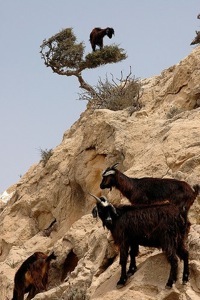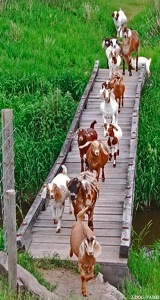Habitat and Geography

“Home Sweet Home”
Capra hircus was first domesticated from the feral
goat 8-10,000 years ago in the highland areas
of western Asia. They were the first of the
ruminants, or animals with four-chambered
stomachs, to be domesticated and have thrived in
their domestic lifestyle since. As domestic animals,
they frequently live in similar habitats as
other domestic animals such as cows, sheep and
pigs.
For more information on the goat’s four-chambered
stomach, see Nutrition.
Of all the domestic animals, goats have the largest
ecological range. Domestic goats can live in areas
ranging from tropical rain forests to deserts, but
typically goats live in temperate or tropical forests
and grasslands. Feral goats usually live in rugged
mountain areas and alpine meadows. Goats are
grazing animals, so by nature they must live in areas
that have vegetation. However, due to adaptations,
goats can survive in areas with sparse vegetation,
while other grazing animals cannot.
For more information on goat adaptations, see Adaptations
As they spend much of their day grazing in fields, goats are very susceptible to predation by large carnivores. Because of this Capra hircus exhibits instinctual herding in the wild and in captivity are most comfortable when they are in groups of two or more. Herds are typically formed of 5-20 individuals, but can include up to 100.
For more information on predation, see Interactions with Other Species
Because of its domestication, Capra hircus has spread to almost
every region of the globe. In captivity, the goat requires a few
necessities to survive comfortably. With clean, ventilated shelter,
15 square feet of bedded sleeping area and 25 square feet to
exercise, along with some space to graze away from predators,
a domestic goat will flourish. The typical life span of a domestic
goat is between 10 and 15 years, but some have lived to be 22.
To return home, click here.
To learn about the goat adaptations, click here.
Map of Western Asia. Goats were first domesticated in the highland areas.
Image from University of Texas Library Online
Goats living in the mountains.
Photo by Robbie’s Photo Art
A herd of goats crossing a bridge.
Photo by 2-Dog Farm



